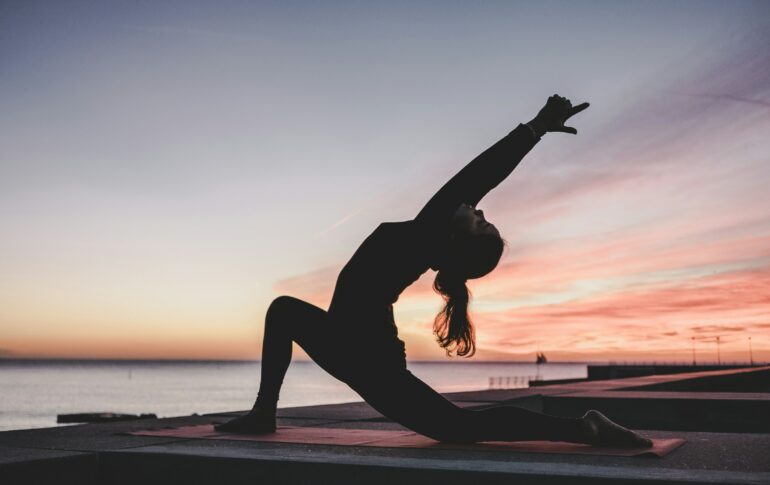Today, it is hard to walk around without bumping into a person wearing Lululemon, Set Active, or any other athleisure clothing. The infamous “yoga pant” has won iconographic status, synonymous with green smoothies and “fitspo” posts on Instagram. To most, the idea of a good workout includes a painful, yet cathartic session of hot yoga—full of five-pound weights, awkward backbends, lavender aromatherapy, and sweltering heat that put the “hot” in yoga. But the commodification of a once only spiritual ritual begs the question: what exactly is yoga, where did it come from, and how did we end up here?
What is Yoga?
Although the modern practice of yoga was recently made public to the masses in the last few decades, “Yoga” has been a common practice of those in the Indian subcontinent since 2700 B.C, originating in the Indus Valley. The word “Yoga” is derived from the Sanskrit root “Yuj”, meaning “to unite”. In essence, yoga aims to unite the mind and body with the ultimate goal of reaching self-realization, a state where the body is free or liberated from suffering of the material world. Freedom from suffering guides traditional practitioners of yoga towards achieving a balance of health both in the body and the mind. During the Classical Period of Yoga, from 500-800 B.C., the eightfold path of Yoga was developed, consisting of components like posture, breathing, asanas (poses), and self-discipline. These physical components formed the backbone of the yoga that is still practiced today, leading the practice towards enlightenment. In this respect, Yoga is associated with “the art and science of healthy living”. However, while yoga simply unites the body with the mind, the spiritual aspect of yoga cannot be understated, as it is a lifestyle that many adopt to “harmonize oneself with the universe”.
Is Yoga Just A Workout?
Yoga began as a spiritual practice, but is mainly known today for the physical benefits as a daily exercise. In the early 20th century, many swamis, or spiritual teachers, started to introduce their teachings to the West. Swami Vivekanada arrived in the U.S. with the goal of making yoga more accessible to Western populations through live demonstrations and translations of sacred Sanskrit yogic texts. As more swamis ventured to the Western world to open more traditional schools of yoga, more people began adopting yoga into their lifestyles. However, these forms of yoga were mainly restricted to the asanas. Most people might know the common postures such as “child’s pose” and “downward dog”. While these forms of yoga are fundamentally important, many Westerners began to simplify yoga down to only these two forms. These days, many yoga classes view yoga as a method of exercise, meant to initiate a sweat, burn calories, and tone the body, while cherry-picking bits and pieces of true yoga. At most, many of these classes will finish with a final breathing session, but to the true practitioners of classical yoga, it is less an homage than it is a weak recreation of an ancient form of meditation.
Yoga and Pain Relief
Emphasizing the history and meaning behind yoga does not mean one should negate the obvious physical benefits it provides. The physical characteristics of yoga are extremely important to understanding the utility of this ritual. These acts also lend yoga to being a useful form of physical relief for people suffering with chronic pain. According to Harvard Medical School, four in five Americans suffer from back pain. However, a 2015 study by Journal of Physical Therapy found that when completing 90-minute sessions of Hatha Yoga per week, which focuses on stretching and breathing techniques, spine mobility in elderly women significantly improved. Osteoarthritis is another common condition that results in joint stiffness and long-term pain due to age-related degradation of cartilage and joint linings. A 2014 study by Harvard Health discovered that women who completed an hour session of yoga per week resulted in a “38% reduction of pain and a 35% reduction of stiffness”. While elements of yoga such as frequent stretching and focus of flexibility promote low-impact movements necessary to alleviate chronic pain, is there a scientific reason for these results? A 2008 study done by researchers Sarika Arora and Jayashree Bhattacharjee for the International Journal of Yoga show that yoga does indeed lower the activation of the sympathetic nervous system, which is known for its role in “fight or flight” stress responses and lowering heart rate, cardiac output, and blood pressure. Practicing yoga also inhibits the posterior hypothalamus to reduce stress responses. This suppresses the release of adrenocorticotropic hormone from the anterior pituitary gland, which is responsible for helping release cortisol, a major stress hormone.
Yoga and Depression
Although many choose to focus on the physical and athletic characteristics of yoga, the mental relief it provides should not be overlooked. While some people may believe meditation is an act of stillness, yoga uniquely allows meditation to occur through movement. According to the World Health Organization, major depressive disorder is the leading mood disorder, afflicting over 280 million people around the world. Depression results in anhedonia (loss of pleasure), persistent sadness, lack of energy, and feelings of guilt and worthlessness. The cause of depression may be through external factors such as stressors from work, home, or school, or it may be genetic. No matter the cause, depression has become widespread and greatly affects the mental health of those who have it. Some researchers looked into the benefits of yoga to alleviate the symptoms of those with depression. In a review completed in 2017 by Alternative Medicine, researchers concluded that the preliminary evidence of yoga reducing depression was hopeful due to the focus on “mind-body interventions” by helping patients control their breathing, relax, and learn self-regulation. More specifically, another review by Explore: The Journal of Science and Healing suggests that yoga has been shown to “modulate stress-responsive brain regions including the amygdala, hippocampus, and hypothalamus, to improve hypothalamic-pituitary-adrenal (HPA) axis activity, autonomic balance, and inflammation, reducing drive on bottom-up stress pathways”.While yoga should not replace traditional medicine to treat mental disorders, yoga is a useful supplementary method when paired with typical pharmacological approaches.
Despite starting as an ancient form of meditation and self-realization, yoga can be studied for its vast physical and mental benefits. Not only is yoga a useful way to move the body, especially for those experiencing chronic pain, but completing a yoga routine provides solace and calmness to those experiencing stress and mental health issues. However, purely viewing yoga from a dichotic lens does not lend itself to understanding the rich and complex history of this form of prayer. To practice yoga is to recognize a culture and a people and honor a tradition that has enhanced the lives of many throughout generations. Appreciating yoga for its many benefits, not just the ones found in a workout class, is an art that will hopefully be sustained and remembered for future generations.
References
https://www.health.harvard.edu/staying-healthy/the-physical-benefits-of-yoga
https://www.ncbi.nlm.nih.gov/pmc/articles/PMC4339138/
https://www.ncbi.nlm.nih.gov/pmc/articles/PMC3144610/
https://www.cnn.com/2023/05/17/health/depression-rates-gallup/index.html
https://www.ncbi.nlm.nih.gov/pmc/articles/PMC5871291/
https://pubmed.ncbi.nlm.nih.gov/36239640/
https://yoga.ayush.gov.in/Yoga-History/
https://unsplash.com/photos/silhouette-photography-of-woman-doing-yoga-F2qh3yjz6Jk

